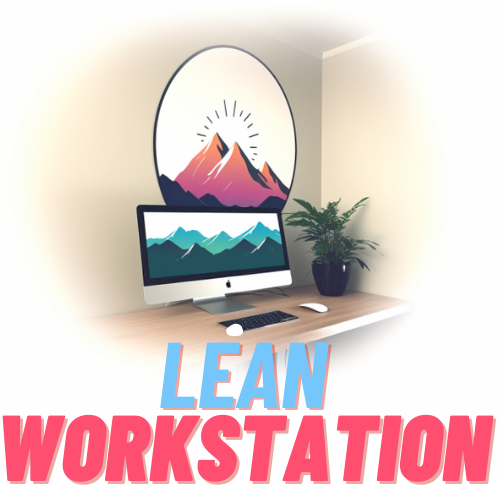
Are you tired of feeling overwhelmed by clutter in your office space? If so, you’re in luck! In this article, we will explore some practical and effective tips for keeping a minimalist office organized. From decluttering techniques to storage solutions, we’ve got you covered. So, whether you’re a seasoned minimalist or just starting on your journey to a more organized workspace, read on to discover how to create a serene and productive environment.
1. Decluttering
1.1 Evaluate What You Need and What You Don’t
When it comes to keeping your office organized, the first step is to evaluate what you need and what you don’t. Take a look at your desk, shelves, drawers, and storage spaces and identify items that are essential for your work and those that are simply taking up space. Be honest with yourself and ask if you truly need certain items or if they can be discarded or donated. By decluttering and removing unnecessary items, you’ll create a clean and efficient workspace.
1.2 Set Aside Time for Regular Decluttering Sessions
Decluttering isn’t a one-time task; it’s an ongoing process. To maintain a minimalist office, it’s important to set aside regular time for decluttering sessions. This could be once a week or once a month, depending on your schedule and the amount of clutter you accumulate. Dedicate a specific time to go through your desk, shelves, and storage areas to remove any items that are no longer needed or don’t serve a purpose in your workspace. By making decluttering a habit, you’ll prevent clutter from accumulating and ensure a tidy office environment.
1.3 Create a System for Sorting and Organizing Items
To effectively maintain a minimalist office, it’s necessary to create a system for sorting and organizing items. This means assigning specific places for different types of items and ensuring they are consistently returned to their designated spots. Use organizers, trays, or dividers to keep smaller items neatly arranged and easily accessible. Consider implementing the “one in, one out” rule, where every time you bring in a new item, you remove an old one. This will help prevent your workspace from becoming overwhelmed with unnecessary items.
1.4 Consider Going Paperless
In today’s digital age, going paperless can significantly contribute to maintaining a minimalist office. Rather than printing every document or memo, opt for digital alternatives. Utilize cloud storage services or document management software to store and organize your digital files. By reducing the amount of physical paper in your office, you’ll not only save space but also contribute to a more sustainable and environmentally friendly workspace.
2. Efficient Storage Solutions
2.1 Utilize Vertical Space with Shelves or Wall-mounted Organizers
When it comes to storage in a minimalist office, utilizing vertical space is key. Consider installing shelves or wall-mounted organizers to maximize the use of wall space. This will free up valuable desk or floor space and provide a visually clean and organized look. Use these vertical storage solutions to store books, binders, or decorative items that add a touch of personality to your workspace.
2.2 Invest in Filing Cabinets or Storage Boxes
Filing cabinets and storage boxes are essential for keeping important documents and paperwork organized. Invest in high-quality filing cabinets or storage boxes that are durable and aesthetically pleasing. Label each drawer or box to easily identify the contents and create a systematic filing structure. This will allow you to quickly locate and retrieve necessary documents when needed, minimizing the chances of misplacing or losing important information.
2.3 Use Desks with Built-in Storage
If you’re in the market for a new desk, consider choosing one with built-in storage options. Desks with drawers or shelves provide convenient storage for office supplies and equipment. By utilizing the built-in storage, you can keep your desk surface clean and clutter-free, allowing you to focus on your work without distractions. When selecting a desk, prioritize functionality and storage capacity to meet your specific needs.
2.4 Opt for Clear or Labeled Containers
When organizing items in storage boxes or containers, opt for clear or labeled options. Clear containers allow you to easily see the contents without the need to open each box or drawer, saving you time and effort. Labels provide an additional layer of organization and help ensure items are returned to their proper places. By using clear or labeled containers, you can maintain an organized storage system and minimize the chances of misplacing or misidentifying items.
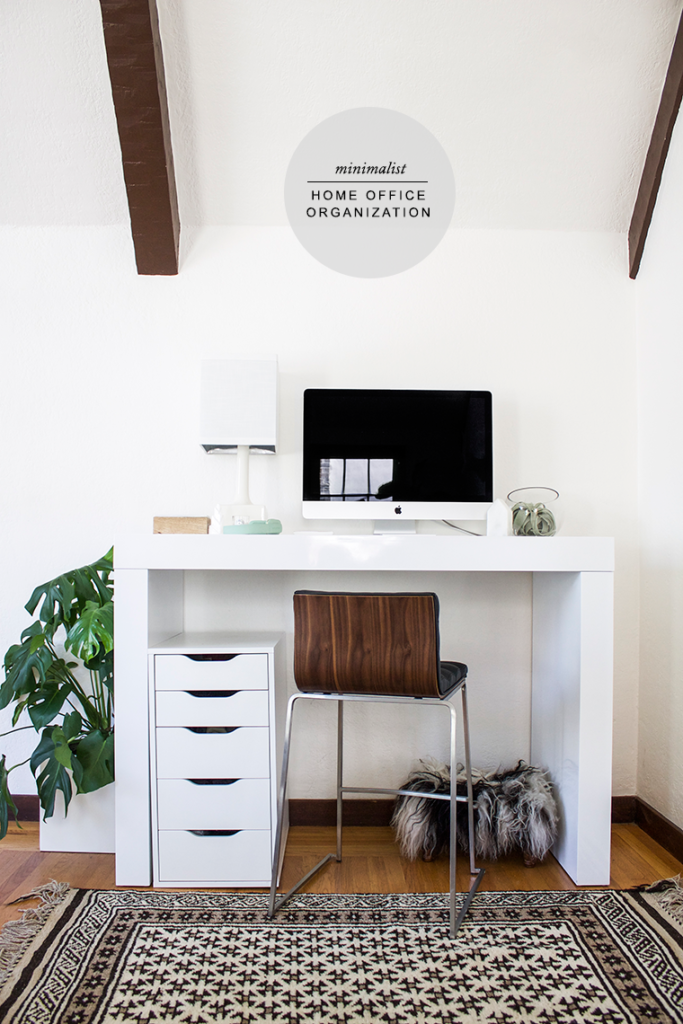
3. Simplify Your Desk Setup
3.1 Keep Only the Essentials on Your Desk
To maintain a minimalist office, it’s important to keep your desk surface free from unnecessary clutter. Only keep essential items on your desk, such as your computer, monitor, keyboard, and a few frequently used stationery items. Remove any items that don’t serve a purpose or are rarely used. This will not only create a clean and visually appealing workspace but also provide you with more room to work efficiently.
3.2 Use Desk Organizers for Stationery and Small Items
Desk organizers are the perfect solution for keeping stationery and small items neatly arranged on your desk. Use pen holders, trays, or drawer dividers to categorize and store different types of stationery. This will ensure easy access to your essentials while keeping them organized and within reach. By having a designated place for each item, you’ll eliminate the need to search for misplaced items and maintain a clutter-free desk.
3.3 Minimize Cable Clutter with Cable Management Solutions
Cable clutter can quickly make your desk appear cluttered and disorganized. Invest in cable management solutions, such as cable clips, cable sleeves, or cable trays, to keep your cables tidy and out of sight. Bundle cables together and route them along the back of your desk or through cable management channels to create a clean and streamlined look. Minimizing cable clutter will not only improve the aesthetics of your desk but also make it easier to keep the area clean.
3.4 Arrange Your Desk for Optimal Workflow
When setting up your desk, consider the flow of your work and arrange your items accordingly. Position your computer or laptop in a central location for easy access and comfort. Keep frequently used items within arm’s reach, such as a notebook, pen, or phone. Arrange your desk in a way that promotes an efficient workflow and minimizes the need for unnecessary movement or distractions. This will improve your productivity and contribute to a well-organized office.
4. Digital Organization
4.1 Organize Your Digital Files and Folders
Just like physical clutter, digital clutter can also hinder productivity and create a disorganized workspace. Take the time to organize your digital files and folders in a logical and systematic way. Create main folders for different categories and subfolders within them for specific projects or tasks. Use descriptive and consistent naming conventions for your files to easily locate and manage them. Regularly declutter your digital files by deleting or archiving those that are no longer relevant or necessary.
4.2 Utilize Productivity Apps and Software
There are countless productivity apps and software available that can help you streamline your digital organization. Consider using task management apps, note-taking apps, or project management tools to keep your work organized and easily accessible. These tools can help you prioritize tasks, set deadlines, and collaborate with others effectively. Experiment with different apps and software to find the ones that suit your workflow best and integrate seamlessly into your digital organization system.
4.3 Streamline Email Management
Emails can quickly become overwhelming and contribute to digital clutter. Implement strategies to streamline your email management and keep your inbox organized. Set up folders or labels to categorize incoming emails and create rules or filters to automatically sort them. Take advantage of features like snooze or archive to keep your inbox clean and prioritize important messages. Regularly unsubscribe from newsletters or mailing lists that no longer provide value to minimize unnecessary email clutter.
4.4 Back up Important Data Regularly
Data loss can be disastrous for your work, so it’s crucial to regularly back up important data. Set up automatic backups for your computer or utilize cloud storage services to ensure your data is protected. By regularly backing up your files, you can have peace of mind knowing that even in the event of an unforeseen incident, such as hardware failure or accidental deletion, your data will be safely stored and easily recoverable.
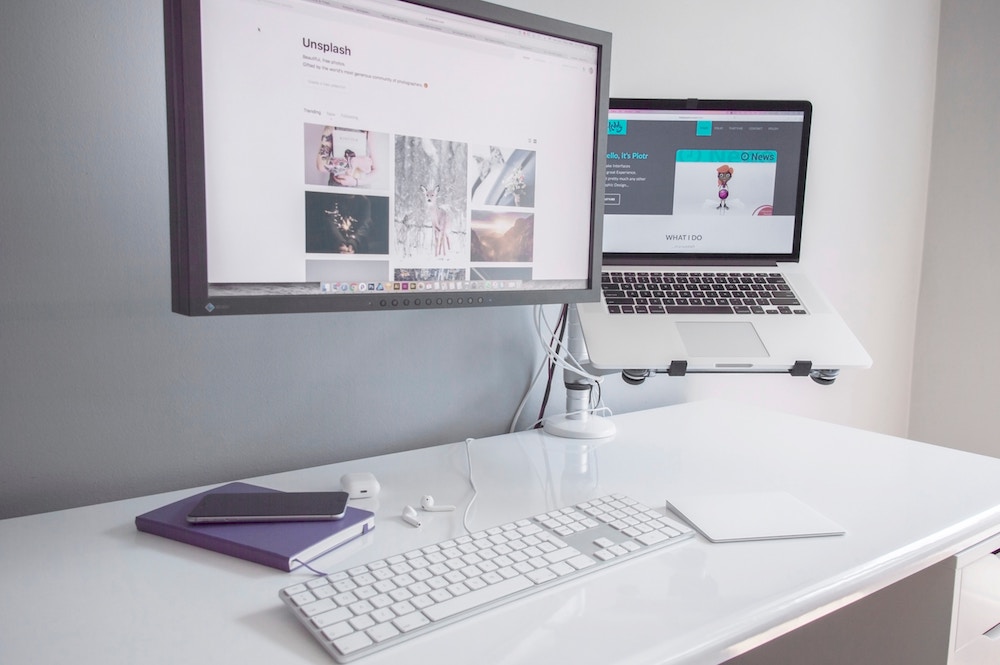
5. Minimize Distractions
5.1 Create a Dedicated Workspace
Creating a dedicated workspace is essential for minimizing distractions and maintaining focus. Designate a specific area in your office solely for work-related tasks. This could be a separate room or a designated corner in a multi-purpose space. By having a designated workspace, you’ll be able to mentally separate work from other aspects of your life, making it easier to stay focused and productive.
5.2 Use Noise-Canceling Headphones or White Noise Machines
Noise can be a major distraction in the office environment. Invest in noise-canceling headphones or consider using a white noise machine to minimize background noise and create a more conducive working atmosphere. Noise-canceling headphones block out external sounds, allowing you to concentrate on your tasks without being disrupted. White noise machines emit a steady background noise that can help mask other distracting sounds in the office.
5.3 Establish Boundaries with Colleagues or Family Members
To minimize distractions in your office, it’s important to establish boundaries with colleagues or family members who may share the same space. Clearly communicate your working hours and let them know when you need uninterrupted time for focused work. Set expectations regarding noise levels and interruptions during these periods. By establishing boundaries and open lines of communication, you can create a respectful work environment that minimizes disruptions.
5.4 Limit Access to Social Media and Non-essential Websites
Social media and non-essential websites can be major sources of distraction. Minimize the temptation to browse these sites during work hours by limiting your access. Use website blockers or productivity apps that help you stay focused by blocking or restricting access to certain websites or applications. By removing these distractions, you’ll be able to maintain your focus and productivity throughout the day.
6. Implement a Daily Cleaning Routine
6.1 Clear Your Desk at the End of Each Day
At the end of each day, take a few minutes to clear your desk of any items that have accumulated throughout the day. Return stationery to their designated organizers, file away any loose papers, and put away any other items that don’t belong on your desk. Clearing your desk at the end of each day will create a clean and fresh start for the next day and help you maintain an organized workspace.
6.2 Wipe Down Surfaces and Equipment
Regularly wiping down surfaces and equipment is an important part of maintaining a clean and organized office. Use disinfectant wipes or a damp cloth to wipe down your desk, keyboard, mouse, and other frequently touched surfaces. This will help prevent the build-up of dust, germs, and bacteria, ensuring a hygienic workspace. Incorporate this cleaning routine into your daily or weekly schedule to promote a healthy and organized office environment.
6.3 Empty Trash and Recycling Bins Regularly
To prevent your office from becoming cluttered and unsightly, make it a habit to empty your trash and recycling bins regularly. Dispose of any waste responsibly and ensure bins are emptied and cleaned as needed. This will not only maintain a clean and pleasant office environment but also prevent the accumulation of trash that can attract pests or produce unpleasant odors.
6.4 Clean and Dust the Office Space
In addition to regular cleaning of your desk and equipment, it’s important to clean and dust the entire office space. Dust shelves, windowsills, and other surfaces using a microfiber cloth or duster. Vacuum or sweep the floor regularly to remove any dirt or debris. A clean and dust-free office space promotes a healthy and organized environment, allowing you to work more efficiently and comfortably.
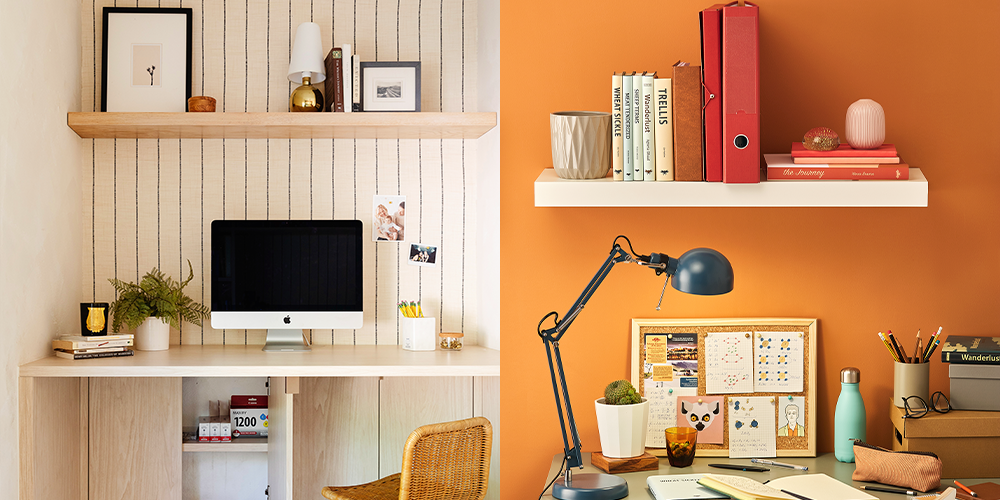
7. Prioritize Organization in Meetings
7.1 Prepare and Share Agendas in Advance
To ensure productive and well-organized meetings, it’s crucial to prepare and share agendas in advance. Clearly outline the topics to be discussed, the goals of the meeting, and any materials or information attendees should review beforehand. Distribute the agenda in a timely manner to allow participants to come prepared and know what to expect. By setting the right expectations and providing structure, you can make the most of your meeting time and ensure everyone is on the same page.
7.2 Use Note-Taking Apps or Tools to Capture Meeting Information
Capturing meeting information is essential for effective organization. Instead of relying on handwritten notes that can easily be misplaced or lost, consider using note-taking apps or tools. These digital solutions allow you to organize and search your meeting notes easily. You can create separate notebooks or folders for different projects or topics, making it convenient to revisit and reference information as needed. By utilizing note-taking apps or tools, you’ll have a centralized location for all your meeting-related notes and materials.
7.3 Assign Action Items and Follow-Up Deadlines
To ensure accountability and progress after a meeting, it’s important to assign action items and follow-up deadlines. Clearly identify the tasks that need to be completed, specify who is responsible for each task, and set realistic deadlines. Document these action items and deadlines in your meeting notes or a shared project management tool. This will help track progress, ensure timely completion of tasks, and maintain a well-organized workflow.
7.4 Keep Meeting Spaces Neat and Tidy
Maintaining an organized meeting space contributes to a productive and professional atmosphere. Before each meeting, take a few minutes to tidy up the area. Clear away any unnecessary items, wipe down the table, and ensure there are enough chairs and writing materials for all participants. Keeping the meeting space neat and tidy will foster a positive and organized environment, enhancing the effectiveness of the meeting.
8. Manage Paperwork Effectively
8.1 Create a Filing System for Physical Documents
Despite efforts to go digital, physical documents may still be a part of your office organization. Create a filing system for these physical documents to keep them organized and easily accessible. Use labeled folders, dividers, or color-coded systems to categorize different types of documents. Arrange the files in alphabetical, numerical, or chronological order based on your needs. Regularly review and update the filing system to ensure it remains efficient and relevant.
8.2 Sort and File Papers Immediately
To prevent paper clutter from accumulating, it’s important to sort and file papers immediately. As soon as you receive a document, take a moment to determine its importance and relevance. If it’s necessary to keep, assign it to the appropriate category and file it accordingly. If it’s not needed, dispose of it properly through recycling or shredding. By dealing with papers promptly, you’ll prevent them from piling up and maintain an organized office space.
8.3 Digitize Important Documents
To further reduce paper clutter and enhance accessibility, consider digitizing important documents. Utilize scanning or document management software to convert physical documents into digital files. Organize these digital files in a logical and systematic way, similar to how you would organize physical documents. Digitizing important documents not only saves space but also provides a backup in case the physical copies are lost or damaged.
8.4 Dispose of Unnecessary Paperwork
Regularly review your physical documents and dispose of unnecessary paperwork. Shred or recycle outdated or irrelevant documents to maintain a clutter-free office space. Create a schedule for purging old documents, such as annually or biannually, to ensure you stay organized and free up storage space. By regularly disposing of unnecessary paperwork, you’ll prevent your office from becoming overwhelmed with obsolete documents.
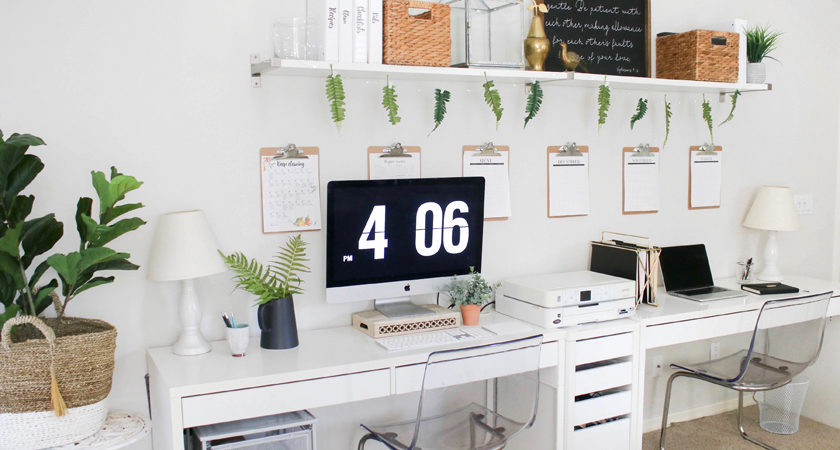
9. Maintain a Minimalist Aesthetic
9.1 Choose a Simple and Clean Design for Furniture and Decor
Maintaining a minimalist aesthetic requires intentional choices when it comes to furniture and decor. Opt for simple and clean designs that promote a sense of calm and order. Choose furniture with minimalist lines and neutral colors. Avoid excessive ornamentation or unnecessary embellishments. Similarly, select decor items that contribute to a clean and clutter-free environment. By incorporating a minimalist aesthetic, you’ll create a visually pleasing office space that promotes focus and productivity.
9.2 Limit Personal Items and Decorations
While it’s important for your workspace to reflect your personality, limiting personal items and decorations is crucial for maintaining a minimalist office. Choose a few meaningful items that inspire or motivate you and strategically place them in your workspace. Avoid excessive personal photos, trinkets, or souvenirs that can clutter your desk or shelves. By keeping personal items to a minimum, you’ll have a more streamlined and organized office environment.
9.3 Opt for Neutral Color Schemes
Color plays a significant role in creating a minimalist aesthetic. Opt for neutral color schemes, such as whites, grays, or earth tones, for your office furniture, walls, and decor. These colors create a sense of tranquility and provide a clean backdrop for your workspace. Avoid bold or vibrant colors that can be visually overwhelming or distracting. By using neutral color schemes, you’ll achieve a cohesive and harmonious look that promotes a minimalist aesthetic.
9.4 Regularly Review and Remove Unnecessary Items
To maintain a minimalist office, it’s important to regularly review and remove unnecessary items. Conduct periodic audits of your workspace, including desk drawers, shelves, and storage areas. Identify items that are no longer relevant or don’t serve a purpose and remove them from your office. This could include outdated reference materials, broken equipment, or excess stationery. By regularly decluttering and removing unnecessary items, you’ll ensure a visually clean and organized office environment.
10. Regularly Review and Update Systems
10.1 Assess the Effectiveness of Your Organization Systems
Periodically assess the effectiveness of your organization systems to ensure they continue to meet your needs. Evaluate whether your filing system, storage solutions, or digital organization methods are efficient and sustainable. Consider if there are any areas that can be improved or streamlined. By regularly reviewing and analyzing your systems, you’ll be able to identify areas for improvement and make adjustments accordingly.
10.2 Make Adjustments to Improve Efficiency
Based on your assessments, make adjustments to your organization systems to improve efficiency. This could involve reconfiguring storage spaces, adopting new digital tools, or refining your filing system. Be open to experimenting with different methods and approaches to find what works best for you. By continuously striving for efficiency, you’ll be able to maintain a well-organized office that supports your work processes.
10.3 Seek Feedback from Colleagues or Employees
Seeking feedback from colleagues or employees can provide valuable insights into the effectiveness of your organization systems. Encourage open communication and ask for suggestions or feedback on areas that can be improved. Take their input into consideration and be willing to make necessary changes. By involving others in the process, you’ll foster a collaborative and productive work environment.
10.4 Stay Open to Trying New Methods
Staying open to trying new methods and approaches is key to maintaining an organized and efficient office. Explore new productivity tools, organization techniques, or workspace designs that may enhance your workflow. Stay informed about industry trends and best practices to ensure you’re utilizing the most effective strategies. Embrace a growth mindset and be willing to adapt and evolve your organization systems as needed.
In conclusion, maintaining a minimalist office requires a combination of decluttering, efficient storage solutions, simplified desk setups, digital organization, minimizing distractions, implementing a daily cleaning routine, prioritizing organization in meetings, managing paperwork effectively, maintaining a minimalist aesthetic, and regularly reviewing and updating systems. By implementing these tips and strategies, you’ll achieve a well-organized office environment that promotes productivity, focus, and a sense of calm.

